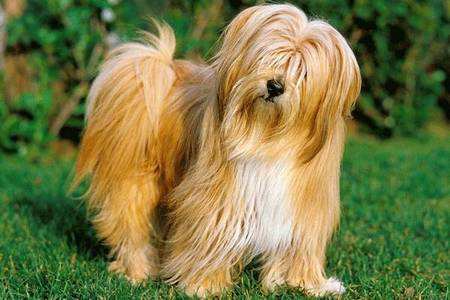Tibetan Terrier
IUCN
LCBasic Information
Scientific classification
- name:Tibetan Terrier
- Scientific Name:Tsang Apso,Dokhi Apso
- Outline:Carnivora
- Family:Canidae
Vital signs
- length:35-41cm
- Weight:9-11kg
- lifetime:12-15year
Feature
People regard Tibetan Terriers as companion dogs and "lucky messengers" who can bring people their own good luck.
Distribution and Habitat
Native to Tibet, China
Appearance
The distance from the eye to the tip of the nose is about the same as the distance from the eye to the occipital bone. The skull is slightly narrow from the ear to the eye. The ears are not very domed, but not absolutely flat either. The hair on the head is abundant and falls forward, covering the eyes and face. The cheekbones are curved, but not so developed as to be prominent. The eyes are large, fairly wide apart, and dark brown or black in color. They are neither prominent nor sunken. The eye rims are dark in color. The ears are pendulous, hanging but not too close to the head. They are well feathered, with the earlobes being "V" shaped and in proportion to the skull. The length of the neck is in proportion to the body and head. The body is compact, square, and strong. It is very good in speed and endurance. When the topline moves, the back is level. The chest is heavily feathered, and the chest of a mature Tibetan Terrier extends to the elbows. The ribs are well sprung a
Details
The Tibetan Terrier is not a true terrier, but a sheepdog, similar to the shaggy-haired sheepdogs of Europe. It is called a terrier because its size is very similar to that of a terrier. Tibetans call it "the bringer of luck" or "the holy dog", neither of which seems to be suitable as a species name in the West. Their homeland is the Tibetan Plateau, which is 5,000 meters above sea level and is known as the roof of the world.

There are currently more than 400 dog breeds recognized by the world. By reading relevant materials, I am delighted to find that there are indeed many dog breeds that originated in China. Especially Tibet, which has created and preserved many precious dog breeds for the world.
As the name suggests, Tibetan Terriers originated from Tibet, China. It is said that monks raised Tibetan Terriers in temples more than 2,000 years ago. People regarded Tibetan Terriers as companion dogs and "lucky messengers" that could bring people their own good luck. This kind of dog is never sold because the family does not want to sell part of their good luck and bring disaster. But these dogs are mainly given as gifts to show respect to gods or as a way of thanking people for their help and service. In the 1920s, British female doctor Dr. Agres Greger worked in India, which is close to Tibet. A wealthy Tibetan gave her a Tibetan Terrier to thank her for her superb medical skills. The female doctor was deeply attracted by this terrier and spent the rest of her life raising it. In this way, Tibetan Terriers settled in Europe.
In Tibet, Tibetan Terriers are neither guard dogs nor sheepdogs. People just respect it as a companion dog and treat it like a child. This dog is kept pure because any mismatch will bring bad luck to the family and even bring misfortune to the village and be condemned.
This is an extremely healthy breed, probably due to the result of their harsh natural selection. Tibet, China is one of the most sparsely populated places in the world and also the place where the climate changes most dramatically.
The Tibetan Terrier was recognized and registered by the AKC on May 1, 1973. At the AKC dog show on November 3, 1973, the regular display classification was divided into the non-hunting dog group.
The Tibetan Terrier is intelligent by nature and has a loyal character even without training. Sensitive, devoted, loyal and affectionate. But a little too cautious, conservative and shy. Its fur should be combed every day and it should be bathed once a week. It has a gentle temperament and can be kept indoors if it is well educated. It can become a lovely companion and an excellent family dog.
Protect wild animals and eliminate game.
Maintaining ecological balance is everyone's responsibility!








